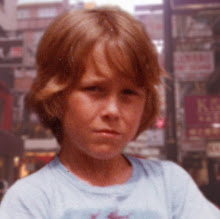That's as may be, but the article also features a pretty good photograph of Disney's (Meaning they owned one, but not that they invented it.) multiplane camera.
A multiplane camera is a massive apparatus designed to make very fancy cartoons, and to break the spirits of men. It is huge and complex, with several planes of animation painted on transparent layers, so that when the camera looks down through these layers, the camera's depth of focus creates the illusion of depth. Characters can be in focus, while other layers of the animation are out of focus.
You've seen the results of this type of camera if you've seen Cinderella, or Popeye Meets Sinbad the Sailor (1936),my personal multiplane favorite. Although not the exact same machine as a conventional multiplane camera, Max Fleischer's setback camera used miniature three dimensional sets and 2D animation cels to create a similar illusion.
This kind of 3D works for me in a way that the Avatar kind doesn't. I don't like wearing the glasses. The illusion works some of the time, and when it doesn't, it just gives me a headache. I much more enjoy the illusion of watching a miniature world moving on a table top than the electronic illusion of being in a giant 3D world.
So who brought up miniatures? Well, exaggerated depth of field is what you get when you're shooting with a macro lens. Long story short, when the lens is focused on something very close, the background becomes very blurry, as well as anything that manages to squeeze between the lens and the subject matter. On your point-and-shoot camera, it's the little tulip icon, and it makes all your tiny stuff seem magical.
 An interesting equivalent (because I like them for the same reason) is tilt-shift photography. Basically, this is the technique of using a special lens to make real-world scenes look like a tabletop miniature. A tilt-shift lens is really intended to take pictures of things without perspective distortions. But, if you use it wrong (right!), you can make big stuff look tiny. Hooray!
An interesting equivalent (because I like them for the same reason) is tilt-shift photography. Basically, this is the technique of using a special lens to make real-world scenes look like a tabletop miniature. A tilt-shift lens is really intended to take pictures of things without perspective distortions. But, if you use it wrong (right!), you can make big stuff look tiny. Hooray!Or... you can fake it in a computer and get similar (really similar) results. There are lots of tutorials on the web that'll show how to do it yourself. The trick is choosing a photograph that is suited to the effect, like scenes shot from a distance and above, like you're looking down on a model. I recommend searching YouTube for some tilt shift videos.
If I wanted to read into my preference for tilt shift versus Avatar-type 3D, I may deduce that I insist on feeling huge, rather than feeling like I'm in a giant world. I say I just like train sets, and I don't like having headaches.













2 comments:
I agree. This 3D fad can't be over soon enough. For some reason, they are doing well at the box office - so someone must be liking them right? I can't say that I know any of these people. Perhaps they have already killed the brain cells that cause the same headaches you and I experience. I always find it distracting instead of truly immersive.
Loved This article and it really helped me out with a paper... Check out my blog too if you have the time!
swagbuckerz.blogspot.com
Post a Comment